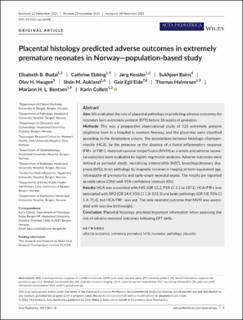Placental histology predicted adverse outcomes in extremely premature neonates in Norway-population-based study
Budal, Elisabeth Berge; Ebbing, Cathrine; Kessler, Jørg; Bains, Sukhjeet; Haugen, Olav H.; Aukland, Stein Magnus; Eide, Geir Egil; Halvorsen, Thomas; Bentsen, Mariann; Collett, Karin
Journal article, Peer reviewed
Published version

Åpne
Permanent lenke
https://hdl.handle.net/11250/2891116Utgivelsesdato
2021Metadata
Vis full innførselSamlinger
- Department of Clinical Medicine [2066]
- Registrations from Cristin [9791]
Sammendrag
Aim
We evaluated the role of placental pathology in predicting adverse outcomes for neonates born extremely preterm (EPT) before 28 weeks of gestation.
Methods
This was a prospective observational study of 123 extremely preterm singletons born in a hospital in western Norway, and the placentas were classified according to the Amsterdam criteria. The associations between histologic chorioamnionitis (HCA), by the presence or the absence of a foetal inflammatory response (FIR+ or FIR−), maternal vascular malperfusion (MVM) as a whole and adverse neonatal outcomes were evaluated by logistic regression analyses. Adverse outcomes were defined as perinatal death, necrotising enterocolitis (NEC), bronchopulmonary dysplasia (BPD), brain pathology by magnetic resonance imaging at term-equivalent age, retinopathy of prematurity and early-onset neonatal sepsis. The results are reported as odds ratios (ORs) with 95% confidence intervals (CIs).
Results
HCA was associated with NEC (OR 12.2, 95% CI 1.1 to 137.1). HCA/FIR+ was associated with BPD (OR 14.9, 95% CI 1.8–122.3) and brain pathology (OR 9.8, 95% CI 1.4–71.6), but HCA/FIR− was not. The only neonatal outcome that MVM was associated with was low birthweight.
Conclusion
Placental histology provided important information when assessing the risk of adverse neonatal outcomes following EPT birth.
